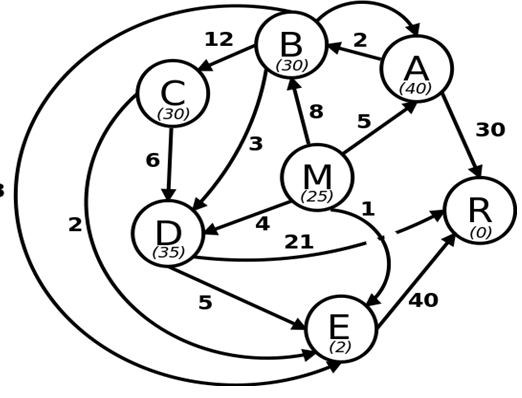As you get close to graduating MIT, you decide to do some career planning. You create a graph of your options where the start node is M = MIT and your goal node is R = Retire, with a bunch of options in between. Your graph includes edge distances that represent, roughly, the “cost of transition” between these careers (don't think too hard about what this means). You also have heuristic node-to-goal distances which represent your preconceptions about how many more years you have to work until you retire. For example, you think it will take 25 years to go from MIT (M) to retirement (R), 30 years from Grad School (B), but only 2 years from Entrepreneur (E). A = Wall Street | B = Grad School | C = Professor | D = Government | E = Entrepreneur In all search problems, use alphabetical order to break ties when deciding the priority to use for extending nodes. Assume you want to retire after doing the least number of different jobs. Of all the basic search algorithms you learned about(that is, excluding branch and bound and A*) which one should you apply to the graph in order to find a path, with the least search effort, that has the minimum. Implement this scenario with any( uninformed or informed search technique) Write down the python code for the above sc
As you get close to graduating MIT, you decide to do some career planning. You create a graph of your options where the start node is M = MIT and your goal node is R = Retire, with a bunch of options in between. Your graph includes edge distances that represent, roughly, the “cost of transition” between these careers (don't think too hard about what this means). You also have heuristic node-to-goal distances which represent your preconceptions about how many more years you have to work until you retire. For example, you think it will take 25 years to go from MIT (M) to retirement (R), 30 years from Grad School (B), but only 2 years from Entrepreneur (E).
A = Wall Street | B = Grad School | C = Professor | D = Government | E = Entrepreneur
In all search problems, use alphabetical order to break ties when deciding the priority to use for extending nodes.
Assume you want to retire after doing the least number of different jobs. Of all the basic search
Write down the python code for the above scenario

Trending now
This is a popular solution!
Step by step
Solved in 2 steps with 2 images


